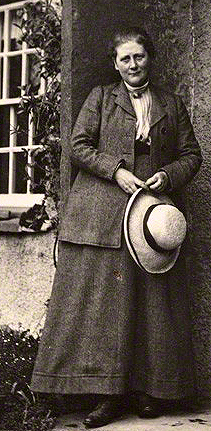Beatrix Potter

Helen Beatrix Potter (/ˈbiːətrɪks/,[1] US /ˈbiːtrɪks/,[2] 28 July 1866 – 22 December 1943) was an English writer, illustrator, natural scientist and conservationist; she was best known for her children’s books featuring animals, such as The Tale of Peter Rabbit.
Born into an upper-middle-class household, Potter was educated by governesses and grew up isolated from other children. She had numerous pets and spent holidays in Scotland and the Lake District, developing a love of landscape, flora and fauna, all of which she closely observed and painted.
Potter’s study and watercolours of fungi led to her being widely respected in the field of mycology. In her thirties, Potter self-published the highly successful children’s book The Tale of Peter Rabbit. Following this, Potter began writing and illustrating children’s books full-time.
Potter wrote thirty books, the best known being her twenty-three children’s tales. With the proceeds from the books and a legacy from an aunt, Potter bought Hill Top Farm in Near Sawrey in 1905; this is a village in the Lake District in the county of Cumbria. Over the following decades, she purchased additional farms to preserve the unique hill country landscape. In 1913, at the age of 47, she married William Heelis, a respected local solicitor from Hawkshead. Potter was also a prize-winning breeder of Herdwick sheep and a prosperous farmer keenly interested in land preservation. She continued to write and illustrate, and to design spin-off merchandise based on her children’s books for British publisher Warne until the duties of land management and her diminishing eyesight made it difficult to continue.
Potter died of pneumonia and heart disease on 22 December 1943 at her home in Near Sawrey at the age of 77, leaving almost all her property to the National Trust. She is credited with preserving much of the land that now constitutes the Lake District National Park. Potter’s books continue to sell throughout the world in many languages with her stories being retold in songs, films, ballet, and animations, and her life is depicted in two films and a television series.
Potter’s family on both sides were from the Manchester area.[3] They were English Unitarians,[4] associated with dissenting Protestant congregations, influential in 19th century England, that affirmed the oneness of God and that rejected the doctrine of the Trinity. Potter’s paternal grandfather, Edmund Potter, from Glossop in Derbyshire, owned what was then the largest calico printing works in England, and later served as a Member of Parliament.[5]
Potter’s father, Rupert William Potter (1832–1914), was educated at Manchester College by the Unitarian philosopher James Martineau.[6][7] He then trained as a barrister in London. Rupert practised law, specialising in equity law and conveyancing. He married Helen Leech (1839–1932) on 8 August 1863 at Hyde Unitarian Chapel, Gee Cross. Helen was the daughter of Jane Ashton (1806–1884) and John Leech, a wealthy cotton merchant and shipbuilder from Stalybridge. Helen’s first cousins were siblings Harriet Lupton (née Ashton) and Thomas Ashton, 1st Baron Ashton of Hyde. It was reported in July 2014 that Potter had personally given a number of her own original hand-painted illustrations to the two daughters of Arthur and Harriet Lupton, who were cousins to both Beatrix Potter and Catherine, Duchess of Cambridge.[6][8]
Potter’s parents lived comfortably at 2 Bolton Gardens, West Brompton, where Helen Beatrix was born on 28 July 1866 and her brother Walter Bertram on 14 March 1872.[9] The house was destroyed in the Blitz. Bousfield Primary School now stands where the house once was. A blue plaque on the school building testifies to the former site of the Potter home.[10] Both parents were artistically talented,[11] and Rupert was an adept amateur photographer.[12][13] Rupert had invested in the stock market, and by the early 1890s, he was extremely wealthy.[14]
